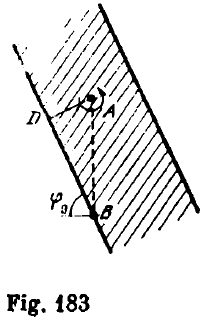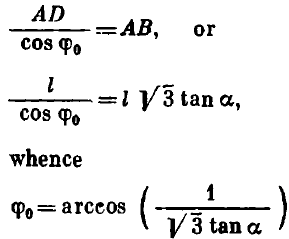By hypothesis, the coefficient of sliding friction between the pencil and the inclined plane satisfies the condition μ ≥ tan α Indeed, the pencil put at right angles to the generatrix is in equilibrium, which means that mg sin α = Ffr, where mg is the force of gravity, and Ffr is the force of friction. But Ffr ≤ μmg cos α. Consequently, mg sin α ≤ μmg cos α, whence μ≥ tan α. Thus, the pencil will not slide down the inclined plane for any value of the angle φ.
The pencil may start rolling down at an angle φ such that the vector of the force of gravity

"leaves" the region of contact between the pencil and the inclined plane (hatched region in Fig. 183). In order to find this angle, we project the centre of mass of the pencil (point A) on the inclined plane and mark the point of intersection of the vertical passing through the centre of mass and the inclined plane (point B). Obviously, points A and B will be at rest for different orientations of the pencil if its centre of mass *** stationary. In this case, AB = 2l cos 30° tan α, where 2l is the side of a hexagonal cross section of the pencil, and 2l cos 30° is the radius of the circle inscribed in the hexagonal cross section.
As long as point B **** in the hatched region, the pencil will not roll down the plane. Let us write the condition for the beginning of rolling down

Thus, if the angle φ satisfies the condition

the pencil *** in equilibrium. The expression for the angle φ0 is meaningful provided that tan α > 1/√3. The fact that the pencil put parallel to the generatrix rolls down indicates that tan α > 1/√3 (prove this).